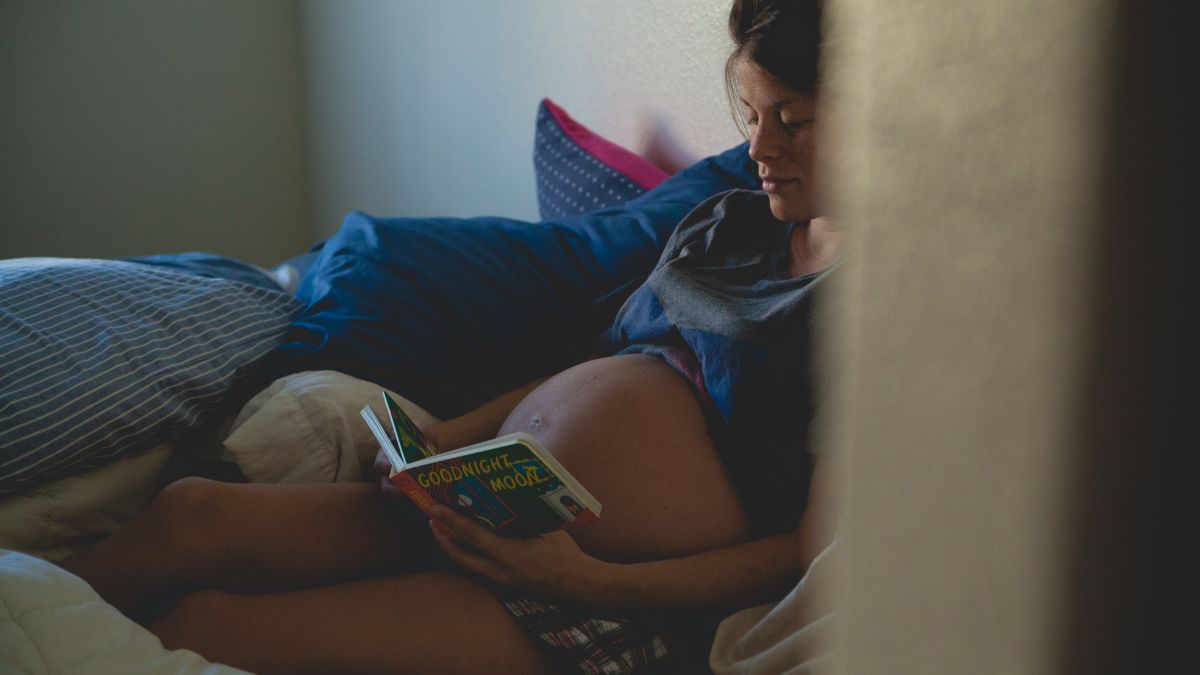Ears and Hearing

While the structural aspect of the ear is usually complete before the third trimester, the development of the auditory system – hearing – develops from the late second trimester to term.
Properly regulated sound, conversation, and music can have beneficial effects on the development of an infant’s hearing, and may in fact, be necessary.
Conversely, it is hypothesized that stressful, loud, intense, and sustained sound may have negative effects on the auditory system.
Research is ongoing to determine the proper volume, timing of gestation, type of sound and music, and what exact benefits (or adverse effects) may be incurred from specific sound exposure during pregnancy.
Background
The ear is divided into three parts: the external ear, the middle ear, and the inner ear. The external and middle ear carry sound into the inner ear.
The two main sensory aspects of the ear – hearing (cochlea) and balance (vestibule) – arise from the same embryonic structure called the otic vesicle (see Structural).
Sound: Sounds waves enter the ear canal and travel through to the ear drum. The ear drum vibrates, which in turn vibrates three small bones in the inner ear. These three small bones amplify sound to the "snail shell", fluid-filled structure called the cochlea ('cochlea' is the Greek word for snail).
The fluid in the cochlea vibrates; the surrounding structures of the cochlea, along with sensory cells similar to hair, then send signals to the brain to interpret the sound.

Structural
The development of the ear is mostly structural in the first half of pregnancy, and the auditory portion develops in the second half.
Early in the 5th week of pregnancy, the internal ear starts to develop, and a hollow pit forms next to the hindbrain during the 6th week (complete by 26 weeks). Retinoic acid (vitamin A) plays an important role in the development of the inner ear, but no supplementation is necessary (nor recommended).

During the 7th week, the outer portion of the ear already has an adult shape, but not location, which occurs around 18 weeks of pregnancy.
The size of the ears is assessed during ultrasound examinations, as abnormally small ears can occur with trisomy 21 and other chromosomal abnormalities.
Hearing
It was first recognized in the 1980s that babies likely hear while in utero and can distinguish and identify voice patterns. Newborns appear to recognize familiar sounds and melodies, to include the sound of their mothers’ voice from other females.

Fetuses start to respond to sound and vibration stimulation from 23 to 28 weeks, based on studies that have shown fetal movement and heart rate response to sound.
The large range in which hearing may start is based on the expectation that all fetuses should respond to sound by 28 weeks, but start to respond as early as 23 weeks. Additionally, the blink-startle response appears from 24 to 25 weeks of pregnancy and is consistently present after 28 weeks.
The period from 25 weeks of pregnancy to 5 to 6 months of age is most critical for the development of the neurosensory part of the auditory system, as the ears become tuned to receive signals of specific frequencies (pitch) and intensities (volume).
The abdomen and uterus filter out most high-frequency sounds and lower decibel (dB) levels by as much as 20 to 35 dB; but external conversations can still be heard by the fetus.
The normal frequency range that can be heard by an adult is between 20 and 20,000 Hertz (Hz); however, fetuses up to 27 weeks hear mostly lower frequencies (below 500 Hz), and higher frequencies after 29 weeks, as the auditory system continues to develop.
Note: Deeper sounds (a male’s voice) tend to have lower frequencies, while higher pitched sounds have higher frequencies (a child’s voice).
Impact of Sound
The auditory system requires outside sound to develop correctly. Therefore, appropriate control of outside noise, exposure to proper speech sounds and music, and the protection of sleep and sleep cycles, are critical for healthy auditory development.

Numerous studies have shown the potential positive effects of music played during utero on the infant and child. However, it is not known which type of music or the most optimal volume, length of time, or stage of pregnancy that would have the most benefit.
Although this research would indicate that sound devices, such as earphones on the abdomen, are a good idea during pregnancy, it is possible that sound directly over the abdomen is not necessary. It is reported that the mother’s voice, gentle background noise and music (played through speakers, not headphones), and the normal sounds of the mother’s body are enough for proper development, and anything more direct could have possible negative effects.
The sound environment a fetus is exposed to during pregnancy helps regulate its neural responsiveness; therefore, it is possible that a “negative” prenatal sound environment could inhibit proper development. Intense and sustained sound may have implications for the developing blood vessels and brain of the fetus, as well as the premature infant that could later impact behavior.
Along this line, research has focused on the negative impact that Neonatal Intensive Care Unit (NICU) sounds can have on preterm infants. The sensory environment of the NICU may have lasting effects on the developing premature brain because the baby does not get the opportunity to identify or “match” the sound to the visual “making” that sound, as other newborns do, outside of the NICU. However, research remains ongoing.
A study from November 2020 recommended the implementation of "quiet time" in NICUs to increase silence and reduce exposure to electronic sounds for infants.

Hearing Loss
Conductive hearing loss occurs when there are defects in either the external or middle ear. When significant, these types of defects are usually accompanied by other abnormalities in the body. Sensorineural hearing loss occurs from defects within the inner ear.
It is estimated that 50% of all congenital hearing loss has genetic causes, where the additional 50% are likely due to environmental causes, such as viruses (i.e. rubella, which also causes vision defects), or certain antibiotics (i.e. gentamycin, tobramycin).
Action
Pregnant women and their partners and family members talking to the baby during pregnancy at a regular rate may be very beneficial to the development of the baby’s hearing. Background music at a relaxing level may also be very beneficial, particularly in the second half of pregnancy.

Pregnant women likely do not need to stress or be too concerned about the auditory environment their baby is experiencing unless this environment is very loud, intense, and sustained for an extended period, especially after delivery. If a woman feels that her home or work environment falls into this category, she should bring her concerns to her HCP.
Although very rare in the United States, rubella infection during the embryonic period is a major cause of abnormal development of the ear and causes defective hearing. Although rubella vaccinations are not recommended during pregnancy, it is most ideal to obtain a booster vaccination prior to pregnancy, if needed (normally a part of the MMR vaccine, for measles, mumps, and rubella) (read Vaccinations).
Although vitamin A is essential for structural fetal ear development (as well as the limbs), supplementation is not necessary during pregnancy unless a woman is deficient, which is very rare in the United States. Further, too much supplemental vitamin A can be harmful during pregnancy (read Vitamin A); therefore, vitamin A supplementation is not recommended. Women should be able to obtain all vitamin A necessary with a varied and healthy diet.
Read more information on the association between fetal hearing and the developing brain.
Resources
Reproductive Health in the Workplace – Noise (U.S. Centers for Disease Control and Prevention)
Conductive Hearing Loss (American Speech-Language-Hearing Association)
Sensorineural Hearing Loss (American Speech-Language-Hearing Association)
Viewer discretion/may be graphic (real embryo trigger): For women who may be interested, a medical photograph of a real fetal cochlea is located here (scroll down) (Cochlea.eu)